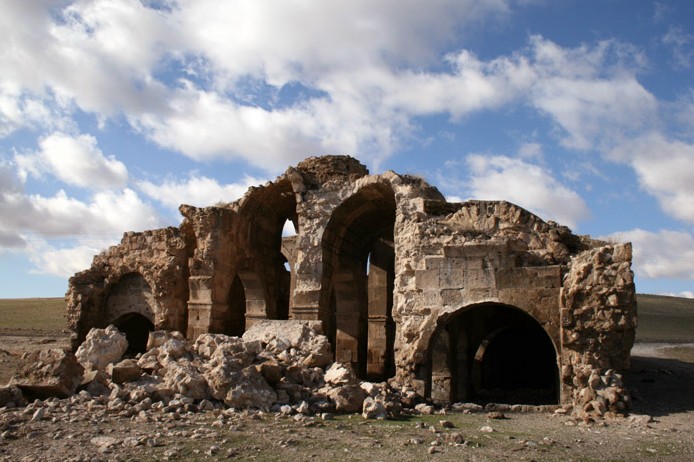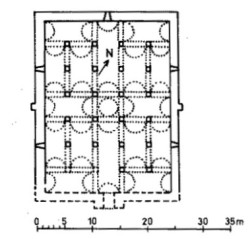ORESIN HAN
|
|
|
|
|
|
|
|
|
|
|
|
DISTRICT
68
AKSARAY
LOCATION
This han is located on the Aksaray-Nevşehir Road, 28 km east of Aksaray, 100 m
from the
northern side of the road. It is 6 km from the Alay han, and 17 km from the
Ağzikara han. The han is located at the crossroads of two caravan routes.
The historical road was an important one in the Roman, Byzantine and Seljuk
periods. No traces of it remain today. A castle, built during the Roman period
and used by the Byzantines and Seljuks, is located in the village of Kalebata,
northwest of the han, on the same caravan route.
NAMES
Tepsidelik Han
Tepeli Delik Han
DATE
1188 (dated by inscription)
Until recently, the Öresin Han is considered to have been built in the third quarter of the 13th century by analysis of the stylistic features. On what must have been an exciting day during the 2007 renovation of the han, Necdet Ozkan discovered the inscription plaque among the fallen stones.
The inscription comprises three lines and reads as follows:
Melih Sultan, son of Kiliç Aslan, the son of Shah the Great Sultan Mesud,
had ordered this han to be built during his reign, in Hijri 584 /A.D. 1188.
REIGN
OF
Sultan Kilicarslan II
PATRON
The patron of the Oresin Han is Melih Sultan Shah, the son of Kilic Arslan II.
His is also known as Kutbeddin Melikshah. Sultan Kiliç Arslan II divided the
country among his 11 sons upon his retirement, and bequeathed the sultanates of
Sivas and Ankara to his son Kutbeddin Melikshah.
BUILDING TYPE
Covered, no courtyard (C)
DESCRIPTION
The han is oriented north-south and is built on a slight incline. The
han consists of a covered section only. No remains of a courtyard were revealed
during the excavations made to the entrance of the han. The han portal faces southeast and has a large hall with five aisles. The plan
displays an unusual layout of the aisles. On either side of the central
aisle are two pairs of vaults running perpendicular to the rear wall, and they
are separated by a central transversal aisle running parallel to the back wall. Two additional vaults running parallel to the rear wall are located on the front
and rear walls. This unusual plan creates four separate sections underneath the
inner vertical pieces.
All the piers of the covered section are square. Lighting was provided by slit windows located in teh northern wall of the middle nave and in the east and west walls of the second and fourth cross vaults.
The raised loading platform of the covered section were in ruins, but were rebuilt during the restoration as indicated by the original traces on the piers.
The stones of the crown door were discovered during the recent excavation project, and it has been restored. The opening is composed of a pointed arch with a flattened arch over the door. The inscription plaque has been reinstalled in its place over the door.
There are two support towers at the center of the east and west walls.
Traces of a well and various architectural remains were discovered in the tumulus in front of the han.
DECORATION
It is not possible to document the original portal decoration in
view of the current ruined state.
DIMENSIONS
Area of hall: 727m2
Outer area: 560m2
STATE OF CONSERVATION, CURRENT USAGE
In 2007, the Turkish General Foundations Directorate ordered a complete
restoration of the han, which was completed in 2010. The dome at the center of
the transepts of the covered section has been covered with a pointed dome. The
han has now been turned into
a tourist restaurant and gift shop.
Although little of the han remained standing before the renovation, the pendentives on the dome, the architectural proportions and the workmanship were impressive. The portal and part of the dome were in ruins, but the spaces covered by cradle vaults and supported by symmetrically placed groups of three columns around the pendentive dome were striking in appearance.
This proud and dignified sentinel stood for many years on this lonely stretch of road, poetically evoking the passage of the Seljuks, Crusaders, and Mongols on these plains.
BIBLIOGRAPHIC REFERENCES
Acun, p. 517.
Baş, A., 2010, p. 71-3
Bektaş, pp. 106-107.
Erdmann, pp. 167-169, no. 51.
Hillenbrand, fig. 6.57, p. 553.
Karpuz, Kuş, Dıvarcı
and Şimşek (2008), vol.
1, p. 69.
Rice, p. 206.
the photos below show the han before the 2009 renovation:
 |
|
|
|
|
|
Karpuz Anadolu Selçuklu Eserleri (2008) v.1, p. 69. |
|

The Oresin Han had a bit role in the 1970 film "You Can't Win 'em All", starring Charles Bronson and Tony Curtis as soldiers of fortune for the Ottoman Sultan in 1922. The film was shot in the region of Avanos, and there is a brief shot of the mounted soldiers passing in front of the han, who comment on how nothing withstands the passage of time, not even a monument as impressive as this one.
|
|
|
|
|
|
©2001-2017, Katharine Branning; All Rights Reserved. No part of this site may be reproduced in any form without written consent from the author.